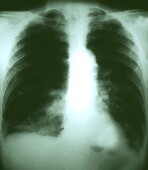
THURSDAY, March 20, 2014 (HealthDay News) — Rates of tuberculosis in the United States are falling, with cases at a historic low, health officials reported Thursday.
Improved screening of immigrants has helped reduce incidence of the highly contagious lung disease, researchers from the U.S. Centers for Disease Control and Prevention said.
“Tuberculosis continues to decline in the United States, and we are at the lowest number of cases since we have been tracking it,” said Dr. Phil LoBue, acting director of the CDC’s division of tuberculosis elimination.
According to preliminary data from the CDC’s National TB Surveillance, fewer than 9,600 cases were reported in the United States in 2013. That represents a decline of 4.2 percent from 2012 — from 3.2 cases per 100,000 people to 3.0 per 100,000.
But health officials aren’t celebrating yet. “We still have a long way to go to reach elimination,” LoBue said.
Cases of drug-resistant tuberculosis remain a concern, and the rate of TB is still 13 times higher for foreign-born residents than for people born in the country, according to figures published in the March 21 edition of the CDC’s Morbidity and Mortality Weekly Report and online in the journal Emerging Infectious Diseases.
Still, a program that more intensively screens anyone planning to immigrate is having success, health officials said.
Under the tighter screening, twice as many TB cases are diagnosed and treated among immigrants and refugees before their U.S. arrival than with the previous screening program, according to the report.
The program is also cost-effective, saving taxpayers $15 million in annual health care costs, the CDC said.
“We are doing well,” LoBue said. “We are making progress, but we still have a long way to go.”
According to the report, four states — California, Florida, New York and Texas — reported more than half of all TB cases in 2013.
Also, blacks and Hispanics have a rate of tuberculosis seven times higher than whites. For Asians, the rate is 26 times higher than whites, the researchers found.
Homeless people and those infected with HIV also are at an increased risk for TB, the researchers said.
Of particular concern is TB that is resistant to the usual drug treatments, CDC officials said. Without effective treatment, TB can kill.
Although these cases remain infrequent in the United States, they are difficult and expensive to treat and can be fatal, CDC epidemiologist Suzanne Marks said.
“Treatment uses very expensive medications and requires hospitalization for about 75 percent of patients,” she said.
On average, the direct cost of treating multi-drug-resistant TB is $134,000, climbing to $430,000 for the most resistant cases, Marks said.
That compares with $17,000 for treating drug-susceptible TB, she said.
“We still have about 1 percent to 2 percent of our TB cases that have significant drug resistance,” LoBue said.
Eighty-six cases of drug-resistant TB were reported in the United States in 2012, the most recent year for which complete data is available. In 2013, two cases of extensively drug-resistant TB were reported nationally, the same as in 2012, the researchers said.
“We have a very strong TB control system in the United States, but there is always a potential risk because drug-resistant TB continues to be a major problem throughout the rest of the world,” LoBue said.
“There is some evidence that it might be slightly increasing,” he said.
Marks said it takes as long as two years to treat drug-resistant TB, compared with six months for drug-susceptible TB.
Although the United States is seeing progress against TB, the disease is epidemic elsewhere. Worldwide, 8.6 million new cases and almost 1 million deaths were reported in 2012, according to the World Health Organization.
Nationally, U.S. health officials know elimination of TB won’t happen anytime soon.
Having less than one case per 1 million people would signal elimination, LoBue said. “At the current rate of decline, we wouldn’t reach that level for about 100 years,” he said.
More information
For more information on tuberculosis, visit the U.S. Centers for Disease Control and Prevention.
Copyright © 2025 HealthDay. All rights reserved.

